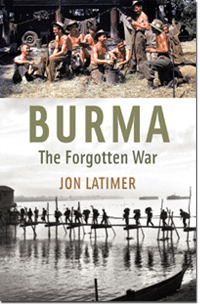Another look at the World War Two Burma theatre
|
|
|
Burma: The Forgotten War by Jon Latimer. John Murray, London. GBP25. |
The title of this book is definitely a misnomer. The fighting in Burma between the Allies and the Japanese Imperial Army can hardly be described as “forgotten.” Only two years ago, the Imperial War Museum in London published a detailed, 456-page volume on the Burma Campaign written by military historian Julian Thompson. Dozens of other books, including a number of classics, have been written on what was one of the bloodiest campaigns in Asia during the Second World War.
The fighting in Burma may, in fact, be one of the most documented wars in modern Asian history. That said, Jon Latimer’s study is worth reading, not because his heroes are “unsung”, as he puts it, but as an authoritative and comprehensive study of the Burma campaign. He chronicles the British defeat, the ensuing stalemate, and then the eventual victory over the Japanese in minute detail. It is also beautifully written.
Latimer, who served for many years with the Royal Welsh Fusiliers, then as a military intelligence officer, is the author of several other books about World War Two. For this book he drew from wartime records in Washington, London, Edinburgh, and the Gurkha Museum in Winchester, and interviews with survivors of the conflict.
The Burma Campaign was one of the biggest multiracial undertakings in the history of warfare. The allied troops came not only from Britain and the United States but also from Canada, Australia, New Zealand, West, East and South Africa, and, overwhelmingly, from India. As Latimer points out, they were “Dogras, Sikhs, Punjabis, Kumaonis, Madrassis and Nepalese, representing every race and caste on the subcontinent.”
Witness the construction of the 1,000-kilometre road from northeastern India through northern Burma to support the forces fighting the Japanese in China. According to Lt-Col Frank Owen, a British war veteran and the author of The Campaign in Burma, yet another book about this supposedly “forgotten” war, “Chinese, Chins, Kachins, Indians, Nepalese, Nagas, Garos slashed, hauled and piled. Negroes drove machines. Black, brown, yellow and white men toiled shoulder-deep in the streams, belt-deep in red mud.” In the surrounding hills and mountains, Kachin and Karen guerrillas staged hit-and-run attacks on Japanese positions.
More than any author before him, Latimer portrays the personalities who led this unique campaign. There was William “Uncle Bill” Slim, the commander of the Fourteenth Army who was backed by the aristocratic Lord Louis Mountbatten, and US General Joseph Stilwell, who became known as “Vinegar Joe” because of his short temper and vitriolic verbal attacks on almost anyone around him, especially his British comrades. Orde Wingate, a British officer, was “a blend of mysticism, passion and complete self-confidence tinged with darkest depression; he was obsessive, rude and overbearing,” according to Latimer. But his special force, code-named the Chindits, thrust far behind the Japanese lines, gravely disrupting the enemy’s supply lines. Wingate did not live to see the Japanese defeated. He died in a plane crash in Burma in 1944.
Following the routing of the Japanese, the camaraderie of the trenches swiftly dissipated. Latimer deals with the immediate consequences and then the legacies of the war: the gasping last breaths of British colonial triumphalism; the renewed push for autonomy on the part of the colonies; the rise of a military regime in Burma; the seemingly never-ending insurgencies among some of the tribes that were armed by the Allies to fight against the Japanese, who after independence turned their guns on their respective governments.
The Karen, the Kachin and other groups fought for years for sovereignty from Rangoon. In northeastern India, from where the campaign was launched, the Naga have fought ever since independence from Britain for independence from India—and that may indeed be a “forgotten war” as it, unlike Burma’s tribal insurgencies, has received very little attention outside the region and almost no coverage in the international media.
Burma: The Forgotten War is more than just a history of the World War Two Burma Theater, it is an account of how Asia’s old order collapsed and gave way to new realities. It also stands out for its poignant post-war and post-colonial anecdotes.
Most Allied veterans carried into peace “the same abiding hatred” of their wartime adversary. But David Wilson, chairman of the Burma Star Association of war veterans, once invited his former enemies to his home and a war memorial in York where “their emotion [was] quite genuine when they lay their wreaths of chrysanthemums”. When he asked why they held a British memorial in such high esteem, he was told, “because it is part of our history too now. We have nothing in Japan to remind us of our friends and relatives who lie with yours in Burma. It is our privilege to remember them here.” (About 190,000 Japanese soldiers, or 60 percent of the men that served in Burma, died there—13 times the number of Allied dead.)
In stark contrast, Latimer also recounts the postwar experience of Mohammed Munsif Khan, the Indian Army soldier who raised the Union Jack over Rangoon when it was retaken from the Japanese. After the partition of India in 1947, he worked in the Pakistan embassy in Beijing, then went to join his son in Britain. But he was stopped at London’s Heathrow airport, and refused entry due to some “administrative error.” Infuriated, he returned his medals, including the Burma Star.

